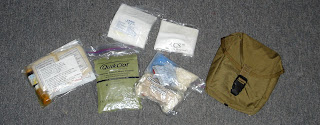Prop strike injuries can resemble battlefield trauma.
So, you might ask yourself, who knows more about treating battlefield trauma than the US Military?

Here is a USMC medical kit that contains everything you're ever likely to need on your worst PPG day ever. In a single MOLLE compatible pouch you have a two combat field dressings, Quick clot, a one-handed tourniquet, and some other stuff.
New, these kits cost around 100 dollars, but DOD regulations say that these packs must be rotated out every five years, and post-dated kits go up regularly on ebay for typically around 25 bucks or so. All the component parts, however, are individually vacuum sealed, and I’m convinced the shelf life for vacuum wrapped cloth bandages is many times longer than five years.
Quickclot, if you don't already know, is a very valuable tool in dealing with serious blood issues, even arterial bleeds. It is a sterile pad pretreated with a hemostatic agent that absorbs the water part of blood and speeds coagulation.
A granular version of the product is shown used to treat a gunshot wound in the movie “Shooter.”
Quickclot Sport packs, are available in 25 and 50 and 100 Gram sizes. Soldiers carry the 100’s but you can use several smaller pads as you need to.
A (very graphic) training video can be seen here, showing Quick Clot being used on a deep wound, and also the use of a military pressure bandage, (H compression style, a Cinch-tight bandage, and a combat tourniquet. (All of which are included in the USMC IFAK kit)
http://www.youtube.com/watch?v=6nRylQ-mJgI
http://www.youtube.com/watch?v=6nRylQ-mJgI
The Quickclot is a potential lifesaver. Ebay online stores have small packs of “Quickclot Sport” for about 10 bucks, and its probably the single most potentially valuable item in my kit. I keep another one in a cargo pocket in my unit, so I'll always have one close at hand while flying.
The IFAK kit has a pouch containing a 4" x 16" sterile gel-soaked burn dressing. Great bit of kit. Also a couple of omni-useful triangular bandages, some Providone-Iodine solution and some miscellaneous bandages. Even some Iodine water purification tablets. I kept them in the case. Why not?
However, I did remove one H-bandage, and one compression bandage from the trauma pouch to make room for some other gear, to make what I feel is a more appropriate Aid Kit for civilian/PPG use.
I suggest filling the space with an aluminized emergency blanket, an Ascheman chest seal, a one way CPR barrier, a couple of pairs of latex (Nitrile actually) protective gloves, some boo-boo bandages, a mini pair of shears, and a haemostat clamp. Most useful of all, of course are Advil and Tylenol and ASA. Tylenol (Acetominephin) is your best over the counter pain killer, for use when bleeding is present, as both Advil (Ibuprophin) and Aspirin (ASA) are vasodialators and hamper blood clotting. Advil is my choice for use as an anti-inflamatory to ward of muscle aches the next day.
The whole kit fits into a MOLLE pouch about 4" x 6" x 7" and can be carried on a belt or a drop-leg rig.
 OTHER STUFF: Sprains are commonplace in PPG, so I keep a MINIMUM of three instant Cold Packs nearby.
OTHER STUFF: Sprains are commonplace in PPG, so I keep a MINIMUM of three instant Cold Packs nearby. Cold packs are sealed bags containing separate compartments of chemicals that when squeezed, mix to promote an endothermic reaction that feels cold to the skin. The cold effect only lasts ten to twenty minutes once they are activated, and you'll want to keep any sprain iced for a longer period than that to reduce the inflammation (swelling) that follows, so extra cold packs are essential to have any hope of getting to some real ice, or an emergency ward.
I keep a bottle of saline solution in my big FAK in the car. Sterile saline is good for both cooling burns and wetting burn dressings, and for eye irrigation and wound cleaning.
DID YOU KNOW? That simple burns are often more about nerve trauma than actual tissue damage? Keeping a simple boo-boo burn under a running tap for five minutes or longer, can chill the nerve endings and largely eliminate or reduce consequent swelling and discomfort. Keep the burn under uncomfortably cold running water for quite a bit longer than you think it needs. If it still hurts when you take the affected area out from under the tap, put it back in.
I hate burns. Take the time to do this, and you'll save yourself hours or days of later discomfort.
The short term discomfort of very cold tap water on your skin will be offset by way of reduced injury, less trauma, and faster recovery.
No comments:
Post a Comment